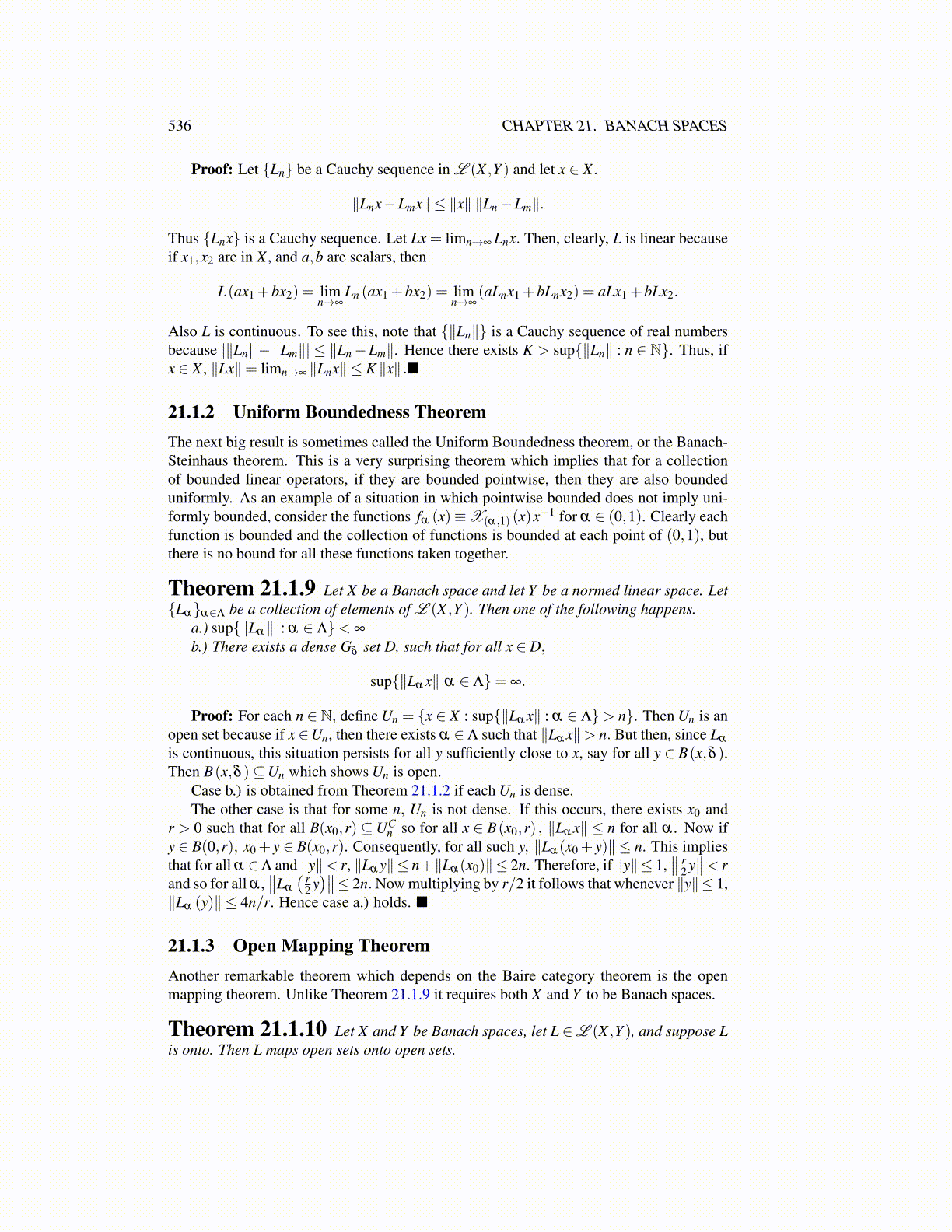
536 CHAPTER 21. BANACH SPACES
Proof: Let {Ln} be a Cauchy sequence in L (X ,Y ) and let x ∈ X .
∥Lnx−Lmx∥ ≤ ∥x∥ ∥Ln−Lm∥.
Thus {Lnx} is a Cauchy sequence. Let Lx = limn→∞ Lnx. Then, clearly, L is linear becauseif x1,x2 are in X , and a,b are scalars, then
L(ax1 +bx2) = limn→∞
Ln (ax1 +bx2) = limn→∞
(aLnx1 +bLnx2) = aLx1 +bLx2.
Also L is continuous. To see this, note that {∥Ln∥} is a Cauchy sequence of real numbersbecause |∥Ln∥−∥Lm∥| ≤ ∥Ln−Lm∥. Hence there exists K > sup{∥Ln∥ : n ∈ N}. Thus, ifx ∈ X , ∥Lx∥= limn→∞ ∥Lnx∥ ≤ K ∥x∥ .■
21.1.2 Uniform Boundedness TheoremThe next big result is sometimes called the Uniform Boundedness theorem, or the Banach-Steinhaus theorem. This is a very surprising theorem which implies that for a collectionof bounded linear operators, if they are bounded pointwise, then they are also boundeduniformly. As an example of a situation in which pointwise bounded does not imply uni-formly bounded, consider the functions fα (x)≡X(α,1) (x)x−1 for α ∈ (0,1). Clearly eachfunction is bounded and the collection of functions is bounded at each point of (0,1), butthere is no bound for all these functions taken together.
Theorem 21.1.9 Let X be a Banach space and let Y be a normed linear space. Let{Lα}α∈Λ be a collection of elements of L (X ,Y ). Then one of the following happens.
a.) sup{∥Lα∥ : α ∈ Λ}< ∞
b.) There exists a dense Gδ set D, such that for all x ∈ D,
sup{∥Lα x∥ α ∈ Λ}= ∞.
Proof: For each n ∈ N, define Un = {x ∈ X : sup{∥Lα x∥ : α ∈ Λ}> n}. Then Un is anopen set because if x ∈Un, then there exists α ∈ Λ such that ∥Lα x∥> n. But then, since Lα
is continuous, this situation persists for all y sufficiently close to x, say for all y ∈ B(x,δ ).Then B(x,δ )⊆Un which shows Un is open.
Case b.) is obtained from Theorem 21.1.2 if each Un is dense.The other case is that for some n, Un is not dense. If this occurs, there exists x0 and
r > 0 such that for all B(x0,r) ⊆UCn so for all x ∈ B(x0,r) , ∥Lα x∥ ≤ n for all α . Now if
y ∈ B(0,r), x0 + y ∈ B(x0,r). Consequently, for all such y, ∥Lα(x0 + y)∥ ≤ n. This impliesthat for all α ∈Λ and ∥y∥< r, ∥Lα y∥≤ n+∥Lα(x0)∥≤ 2n. Therefore, if ∥y∥≤ 1,
∥∥ r2 y∥∥< r
and so for all α ,∥∥Lα
( r2 y)∥∥≤ 2n. Now multiplying by r/2 it follows that whenever ∥y∥≤ 1,
∥Lα (y)∥ ≤ 4n/r. Hence case a.) holds. ■
21.1.3 Open Mapping TheoremAnother remarkable theorem which depends on the Baire category theorem is the openmapping theorem. Unlike Theorem 21.1.9 it requires both X and Y to be Banach spaces.
Theorem 21.1.10 Let X and Y be Banach spaces, let L ∈L (X ,Y ), and suppose Lis onto. Then L maps open sets onto open sets.